Back in the late 80s, our company managed to procure the complete 28 volume MIT Radiation Laboratory (Rad Lab) series, published in 1947, for the company library. To me, these books were interesting because I like history and old technology, but I didn’t understand why everyone was so excited about the acquisition. Only a cursory glimpse at the volumes would reveal that the “circuits” these books described used vacuum tubes and their “computers” were made from mechanical linkages. This was the 1980s, and we worked with modern radar and communications systems using semiconductors, integrated circuits, and digital computers. How could these old musty books possibly be of any practical use? To my surprise, it turned out that indeed they could, and eventually I came to appreciate the excitement. I even used several of them myself over the years.
Radiation Lab? Nuclear Radar?
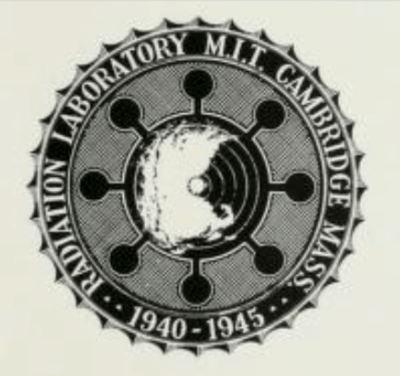
In the years leading up to WW2, the idea of a civilian organization of scientists that would operate independently of the military and government bureaucracies was being championed by Dr. Vannevar Bush. The military and scientists had not worked well together during the first World War, and it looked like science and technology would be playing a much bigger role in the future.
It seemed certain that America would enter the conflict eventually, and Dr Bush and others believed that a new organizational framework was called for. To that end, the National Defense Research Committee (NDRC), which later became the Office of Scientific Research and Development (OSRD) was pitched to President Roosevelt and he approved it in June of 1940.
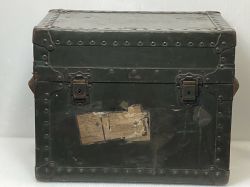
Almost immediately, a gift fell in the lap of the new organization — the Tizard Mission which arrived in the states from the UK in Sep 1940. They brought a literal treasure chest of technical innovations from the British, who hoped that US industry’s cooperation could help them survive what looked like certain and imminent invasion. One of those treasures was the cavity magnetron, which our own Dan Maloney wrote about a few years ago.
Within a few weeks, under the guidance of young Welshman “Taffy” Bowen, they had reviewed the design and gathered up the necessary equipment to fire it up. A 10 kV anode power supply and a 1,500 gauss electromagnet were procured, and the scientists gathered at the Bell Radio Laboratories in Whippany New Jersey on Sunday, Oct. 6, 1940. They powered up the cavity magnetron and were blown away by the results — over 10 kW of RF at 3 GHz (10 cm) from something the size of a bar of soap.
A flurry of activity ensued, and the Radiation Laboratory was formally established on Oct. 25, located at MIT and operating under the umbrella of the NDRC. The name was going to be Microwave Laboratory, but it was changed to Radiation Laboratory instead to mislead any prying eyes as to the focus of their research. At this time, radiation research labs, like Nobel Prize recipient Ernest Lawrence’s Berkeley Radiation Laboratory, were purely scientific in scope without wartime importance.
The Push to Lower Wavelengths
| US Navy CXAM ship-borne radar | VHF | 200 MHz | 1.5 m | 1940 |
| US Army SCR-270 | VHF | 100 MHz | 3 m | 1940 |
| British Chain Home | HF/VHF | 20 – 50 MHz | 15 – 6 m | 1938 |
| British Chain Home Low | VHF | 200 MHz | 1.5 m | 1939 |
| Soviet Union RUS-1 | VHF | 75 MHz | 4 m | 1938 |
Why all the fuss? Although radar systems were in limited use by this time, they all operated in the VHF band. Engineers of the day were familiar with the VHF frequency band and therefore had the design tools and necessary components to build working units. In the late 1930s the British had built an extensive line of coastal defense radar stations called Chain Home, whose operation straddled HF and VHF. Since the war started in Sep 1939, some weaknesses in the system had come to light. The Chain Home Low system at 200 MHz addressed some of these concerns, but the shorter wavelengths of centimetric radar (in the SHF region) promised some real advantages. For example, antennas could be smaller, smaller objects could be detected and located with better accuracy. But there had been no way to generate the necessary transmitter power until the introduction of the cavity magnetron.
Along with the cavity magnetron itself, the British presented their American counterparts with a priority list. They needed three types of radar right away: (1) airborne interception, (2) directing anti-aircraft gunfire, and (3) long range bomber navigation. The Rad Lab concurred, and immediately started three corresponding crash programs.
Project 1: Airborne Intercept Radar
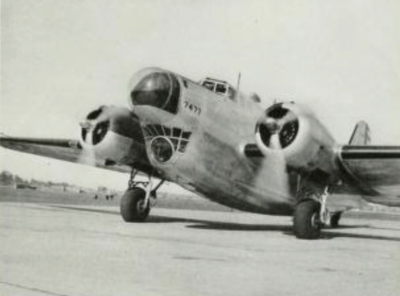
In three months time, the team had their prototype 10 cm airborne radar working. Built in true hacker style, it filled up a whole rooftop and was cobbled together with whatever they could get their hands on. By early January they had a working system with two antennas, and by February they had solved the transmit-receive switch problem and demonstrated successful tracking of aircraft using only “one eye”. By March, they had reduced the sprawling prototype into something that could be installed in an airplane. On its first test flight the crew demonstrated air-to-air detection, and, on a whim, tried and succeeded to detect ships and submarines.
Project 2: Anti-aircraft Gun Radar
This project got into full swing early in 1941. The original ideas presented by the British, indeed how existing VHF-based systems worked, was entirely manual. Radar would find the planes, but people steered the antennas and fired the guns — basically a really improved searchlight. But Rad Lab scientists thought they could do better by automating the whole process. They proved the naysayers wrong, and by May 1941 had a radar working which could automatically track airplanes and pointed a movie camera at the plane. Bell Labs developed an analog fire control computer, and a working system was completed by Apr 1942 (SCR-584 Radar).
Project 3: Long Range Navigation
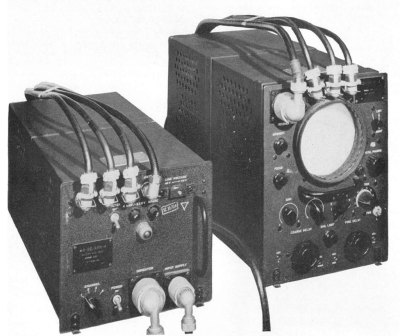
Development of the Long Range Navigation project, or LORAN, began right away. The first pair of stations were under construction by spring. LORAN was the only Rad Lab project not to use microwaves. Instead, it operated around 2 MHz and was used to guide planes and ships. LORAN and its successors continued to be used in the United States until 2010, and in Europe until 2015.
These are only the first three projects. By the end of the war, the Rad Lab had developed and contributed to many other new radar applications as well, including new systems at 3 cm and 1 cm.
Working Environment
The Rad Lab needed people fast, and began recruiting physicist and engineers from universities around the country. By all accounts, it was a great place to work. There was free exchange of ideas, the excitement of pushing new boundaries of engineering and physics. Decades before modems and BBS systems, the internet, or our own weekly Hackaday Chat, Rad Lab staff were having weekly teletype conferences with their colleagues around the world.
The Laboratory never adhered to a rigid organization chart, based on so-called logic or preconceived function; rather the organization was built around the men available. [The policy was to] set the scientists free of non-scientific control. In the last year or two the Laboratory did begin to be more controlled by non-scientific elements. But this came too late to frustrate any important aspects of the program. Rad Lab Founding Director Lee Alvin DuBridge
The ever-present urgency of the war would always weigh upon decisions. Anyone proposing a new idea would always be challenged by associate director I. I. Rabi with the following question: “How many Germans will it kill?”. [Ed Note: Different times!]
Legacy
Besides succeeding with the first three projects, the Rad Lab continued to contribute to and expand the applications of radar. These projects included microwave landing systems, submarine hunting radars, electronic counter-measures and counter-counter measures, identification friend or foe (IFF), early warning radar, and shell fuse radars, among others. At its peak, the Rad Lab employed over 3,000 workers, including several future Nobel Prize winners, including I.I. Rabi (Physics 1944) and Ed Purcell (Physics, 1952) for discoveries concerning nuclear magnetic resonance.

One of the temporary structures built to house the sprawling laboratory in 1943 was simply called Building 20 and became a legend unto itself for decades to follow. Being of temporary construction, people didn’t worry about drilling holes in walls to pass cables. It is said that 20% of all American Physicists worked in Building 20 at one time or another, and earned the name “The Magic Incubator”. It was finally torn down in 1998 to make way for a modern academic complex.
An Encyclopedia of Knowledge
When the war over, the Rad Lab closed up shop on Dec 31, 1945. One final task was to document the work done during the five years of operations. Assistant Director Louis Ridenour led the task, getting the scientists to document their work before returning to normal life. The result was a 28 volume set, including the index.
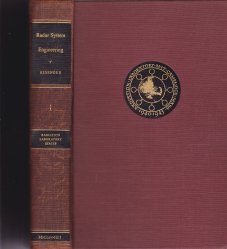
During my years working with radar systems, we routinely used some of these books. It would not be uncommon to hear someone shouting down the hall, “Who stole Silver from my desk last night?” — Samuel Silver was the author of the antenna book, volume 12. I used Marcuvitz’s Waveguide Handbook, volume 10, quite a bit. And when assigned to a project using time-of-flight calculations, I learned a lot from the LORAN book.
In the 2020s, are any of these volumes still important? I’d say the theoretical ones are still valid, but there are probably plenty of other, more modern, texts more easily available. For people into retro circuits, these books have a lot of good example vacuum tube designs to learn from. And if you’re into mechanical computers, the book on computing mechanisms and linkages might be of interest. This series has been long out of print, but they are available from the Internet Archive (link to volume 1).
Banner image courtesy MIT Museum.

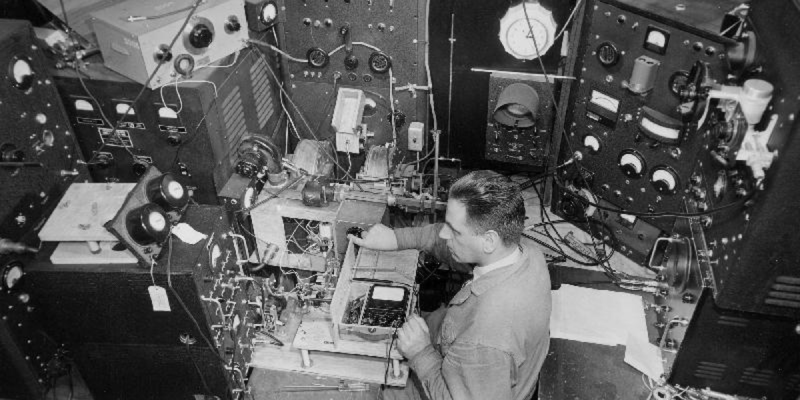
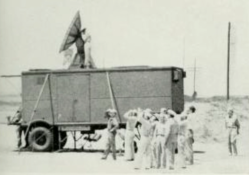
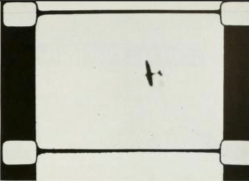














” Anyone proposing a new idea would always be challenged by associate director I. I. Rabi with the following question: “How many Germans will it kill?”. [Ed Note: Different times!]”
Not really. Notice how many video games use Nazis as protagonists.
Wie romantisch. 🙃
But today’s Nazis are not all German.
Biggest one wasn’t German either.
Werent all germans even back then.
I had classes in Building 20 in the late 90s. I had mixed feelings when they tore it down. Felt like we were losing a piece of history, but also you could really tell it was meant to be a temporary structure.
Building 20 was interesting; IIRC really a set of interconnected 3 story buildings with huge wood beams.
Is the man in the picture saying “Press this button to fire the Doom gun”?
LORAN.. LORAN A.. I remember that one from Wikipedia! Wasn’t that the one which did make the amateur’s 160m band unusable for decades?
Yes it was. Radiolocation before GPS.
There is a (possibly experimental) LORAN station in Nevada that is running at this very moment, as I can hear it on my SDR. At 100 kHz. If you’re in central or western U.S. or Canada, you can hear it, too. Raspy sound and fairly wideband. No interference on 160 m though.
Loran C has been around since 1957. Ralph Burhan had plenty of articles in the hibby magazines about suitable antennas and receivers forty years ago.
It’s the rise of that lower frequency Loran that caused the original Loran around 1.8MHz to shut down.
The original Loran meant the 160M ham band had restrictions. My memory from fifty years ago was slices were allocated to regions, and there were severe power restrictions, sometimes even less after sunset. A lot of commercial rigs didn’t bither including 160M.
LORAN C was officially shut down Feb 2010, but has since been reinstated in view of potential GPS vulnerabilities:
gps.gov/policy/loran-c
I toured the third floor of the Old State House in Boston where they keep all the donated junk, and identified a blob of copper and magnet as an old magnetron. Unfortunately there was no identification but it was obviously an experimental model. I wonder if they still have it. (Don’t ask to go up there unless you know somebody.)
The Rad Lab books were still useful into the 70’s and 80’s when I worked at Rome Air Development Center, where the USAF did long range surveillance radar R&D.
I recently finished the book Tuxedo Park by Jennet Conant (granddaughter of that Conant). Alfred Loomis was a non-academic institute scientist who made his fortune on Wall Street. He used his wealth and connections to create and run the radiation lab. He also championed the early nuclear research. He was a patron of Ernest Lawrence and Enrico Fermi.
What are those chunky co-ax connectors called, the ones with the springy wire retaining clip?
I have a few old army surplus ones knocking about somewhere.
Now I have the RF kit, I should characterise them. One day.
Pye.
So cool! Thanks for sharing this, it looks like its going to be a fun read (at least for me).
When I started working at MIT in 1996 my first office in Building 26 looked out over what we the called ‘The old radar buildings’. There was nothing romantic about them anymore, just a bunch of dilapidated shacks. The story went that MIT started demolishing them as quickly as possible because there was the threat that they would become an Historical Landmark. Tearing them down was easier said than done. Underneath the shacks there were concrete basements. Giant jackhammers were needed to cut everyhting out, a process which took more than a year if I remember correctly. That continuous hammering played havoc with the sensitive equipment in my labs, even though most of my stuff was mounted on air suspended tables. Unfortunately these shacks were replaced by the horrible Stata center which is totally out of place on the MIT campus.
I didn’t dig into the Stata Center beyond it being an academic complex. What is it used for? When you say “out of place” do you mean architecturally?
I love seeing articles about 1920-1950 electronics.Thankyou so much ,Ed k1jnh
There is a most interesting book detailing the history of the Rad Lab, ‘The Invention that changed the World’ by Robert Buderi.
I borrowed it from the library 20 years ago and was so impressed by it I went and bought my own copy immediately after returning it. I can thoroughly recommend it to everyone reading here.
It is a good book. I read it out of the library 20 years ago, and couodn’t remember how much applied to the Rad Lab.
One bit I remember was that they had little problem with transmitting tubes at the higher frequencies, but reception was a problem. So diode mixers, they went back to the concept of “” cat whiskers” and upgraded it. Hence solid state diodes in WWII surplus like the 1N21, and I assume why germanium diodes hit the market before transistors.
It’s about radar development, but also about how that WWII work built a foundation for electronics after the war.
“In the late 1930s the British had built an extensive line of coastal defense radar stations called Chain Home”
I’ve always wondered why the German’s didn’t, as far as I know, make these #1 priority targets. The installations I’m thinking of were fixed targets with huge, easily damaged antennas, definitely not mobile which would have made their destruction much more difficult.
The Wikipedia article has a section on it.
Oh, my gosh, am I ever glad to see & read this article! I was born late Feb. 1936, remember Pearl Harbor (too young to understand its significance) and grew up during WW II. In high school days, I visited the NY State library in Albany, and discovered the Rad. Lab. Series. It was very inspiring, and made me choose electronics for my life’s work. I hand–copied ten chapters of Vol. 19, and eventually bought my own copy.
The Series was on CD–ROM.
¶ As a kid, I learned prre–WW II Radio Engineering elements from the 23rd edition of [Understanding Radio] by Watson, Welch, & Eby. Topics included the Heaviside Layer, antennas, amplifiers, oscillators, tuned circuits, detectors, etc. as well as interstage coupling and bypassing.
After studying the Rad. Lab. Series, I realized how limited such concepts were, and had to unlearn/relearn the basics. The contrast was stark.
Thanks for sharing this incredible story. I have been studying the series copies available on The Internet Archive. Your story speaks to the relevance of these publications.
In 1979 when I arrived at MIT I joined the Experimental Study Group, housdx in a wooden “penthouse” stop building 24. The first director, whose name was still on the door, was George Valley. We had an unkempt lab space FL of vacuum pumps and old electronics, and it was fun to rummage around. I was never sure of any of the stuff was from Rad Lab, but the space definitely was. Fun times.
There’s a fantastic resource on Radar at the following URL. I live near RAF Boulmer in the real world and I distinctly remember the ‘Nodding Horrors’ (height finders) operating. Well worth a perusal: https://www.radarpages.co.uk/
Thanks Chris, that was a great article exposing a great body of work. The Rad Lab series was literally a savior to me. I ran across volume 14 of the series which had duplexer information needed for a 24 GHz Doppler product I was developing. I hated losing 3 or more dB in my Gunn Diode circuit so in researching the text, a turnstile type duplexer was described and was exactly what was needed. Amazing that a product developed in the late 90’s used information compiled in the 40’s. They didn’t use 24 GHz in those days but their geometry scaled nicely. I had bought a copy of volume 14 from Amazon 25 years ago which was from the original hardcover series but now that I know how rare these books are I feel a little guilty just buying one book out of the full set of 27.
Thanks for this article. My grandfather worked at Rad Lab and told all sorts of interesting stories about his time there. I even have some of his memorabilia from reunions he attended in the 60s.
Our father worked on Eagle AN/APQ-7 radar system at MIT. “In July (1942) the indicator group work on the project under W. A. Higinbotham. The indicator was to have accurate ground range sweeps combined with computer circuits, together with an expanded sweep indicator for bombing.” Radar in World War II – The History of Modern Physics, Volume 1, 1900-1950 by Henry E. Guerlac